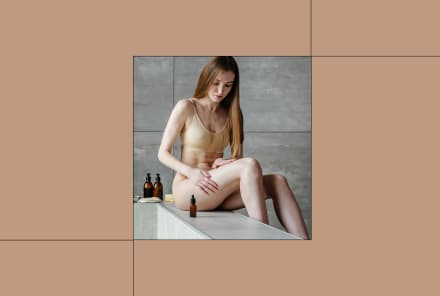Advertisement
Crow's Feet: What Causes Them + 7 Ways To Prevent Those Lines, From Derms

Crow's feet: Of all the types of wrinkles, these are some of the most cited. Because while fine lines have their fair share of names (forehead creases, marionette lines, pillow lines), crow's feet often are one of the first ones to show up. In fact, you can experience them no matter your age (more on that below). And, like other wrinkles, they're difficult to get rid of once they've made their appearance.
Before we go on, we should note: Fine lines happen to us all at some point, and they are signs of a life well lived. Crow’s feet, for example, signal years spent laughing and smiling—and that’s a beautiful thing.
However, you can take steps to delay those lines from taking up permanent residence (i.e., sticking around even when you’re not smiling). Everything you need to know, below.
What are crow's feet?
When you laugh or smile, ever notice how the skin around your eyes tends to crinkle? Those are crow's feet—a type of wrinkle that resembles the talons of a crow, as if one just so happened to plant its feet on the delicate corners of your eyes. And to be clear: Everyone can have them, no matter your age. It's when those lines stick around, without so much as a chuckle, that they seem to raise concern.
What causes those lines?
As mentioned, crow's feet can appear every time you emote throughout the day. But our skin thins as we age (due to a loss of collagen), and the eye area, in particular, is usually the first to show signs.
"When we start to have less collagen and elastic fibers in skin as it ages, this very thin skin shows lines earliest," explains board-certified dermatologist Loretta Ciraldo, M.D., FAAD. That thin skin is also why the area is more sensitive to sun damage, pollution, and oxidative stress—all of which can contribute to sagging skin and wrinkles.
Crow's feet versus fine lines.
It makes sense why people often conflate the two: "Skin biopsies from crow's feet and fine lines from another part of the face would look very much the same," says Ciraldo. But the terms themselves do have their slight differences.
For instance, while both tend to crop up around the eye area, "crow's feet" is a more specific term for those crinkled edges radiating out from the corners of the eyes, versus under the eyes, for example. Fine lines, on the other hand, can refer to any sort of wrinkled skin—be it on the eye, forehead, or décolletage.
They can also differ in size: "Crow's feet can be very thin, fine lines, or they can be very heavy and deep," board-certified dermatologist Jeanine Downie, M.D., explains, whereas fine lines are, well, fine. It's common to use the two interchangeably (and it's totally OK if you do, says Downie); just know that crow's feet are a little more specific anatomically.
5 tips to prevent & get rid of crow's feet.
The key to keeping crow's feet at bay? Early intervention. Here's how to delay the onset of these wrinkles, plus how to manage the lines you've got:
Apply the right topicals.
To target any eye wrinkle (including crow's feet), you'll want to introduce ingredients that increase elasticity and firmness, as well as antioxidants that can nourish and protect the area.
That said, look for formulas that promote cell turnover and collagen production; perhaps seek products with vitamin A (like retinoids), which can gently exfoliate the area and reveal smooth, younger-looking skin underneath.
Ciraldo is also partial to peptides, as these can support your body's natural production of collagen. "Many peptides have been developed specifically to be used around eyes," she notes.
In terms of antioxidants, vitamin C can also support collagen production, and vitamin B is great for toning and soothing the area. Astaxanthin is also a powerful antioxidant that can help manage free radicals from pollution and sun exposure (which, you'll see below, is paramount for delaying crow's feet).*
Protect with sunscreen.
Since the fragile skin is already more prone to sun damage and oxidative stress, you'll want to take extra caution to protect the area. According to Downie, forgoing the SPF can lead to those deep-seated crinkles, as opposed to the finer micro-cracks.
Ciraldo also recommends protecting the entire crow's-foot area with sunglasses—not only to lessen UV damage but also to keep you from squinting into the sun.
Be gentle on the area.
As you tend to the area with products (and remove any eye makeup at the end of the day), make sure not to rub too harshly on that sensitive skin. "Rubbing can influence any wrinkles around your eyes, including crow's feet," says Downie. An itch every now and then won't accelerate the process too much, but be sure you're not applying any unnecessary pressure.
Same goes for when you sleep: Try not to sleep with your face smashed into the pillow; or, if you're an adamant stomach sleeper, you can invest in a silk pillowcase that won't snag the skin.
Keep the skin hydrated.
Think of hydration as a one-two punch: You'll want to lay on ingredients—like hyaluronic acid and ceramides—to lock in moisture, sure, but you also need to approach it internally to really manage crow's feet. Since prevention is the name of the game, take it a step further by supporting your skin's natural hydration levels.
So in addition to loading up on eye creams with ceramides (reminder: Ceramides are a natural part of our skin structure that is able to retain water), perhaps support your body's own ceramides with supplements that can help that barrier stay strong. In fact, studies have shown that oral administration of phytoceramides (which are just plant-based ceramides) improved skin smoothness and elasticity1 in just weeks. Find our favorite beauty supplements with ceramides here.
Try face yoga.
While constantly squinting and emoting is what causes crow's feet in the first place, intentionally toning those facial muscles can promote blood circulation and actually help tighten the area.
Enter: face yoga. Much like a standard vinyasa class, this series of exercises can isolate and tone your muscles—except it's custom-fit for the face. One 2018 study even found that daily face yoga could reduce signs of facial aging2; it does so by stimulating circulation, which can spur the production of collagen and keep your skin looking taut. Try a few exercises that target those delicate eye muscles, which you can find here.
Mind your eye movements.
Now, are we going to deter you from smiling, squinting, or laughing ever again? Absolutely not! But you can consider how your facial muscles rest when you’re not actively engaging. "Of course live your life to the fullest, but if you are at home, resting the muscles on your face helps,” says aesthetic registered nurse Neethi Masur, R.N., at SKINNEY MedSpa.
In office treatments.
You can also go the in-office route, if you’d like. Treatments such as lasers, microneedling, and the like can help stimulate collagen production and smooth out those lines. Just make sure to do your research beforehand and always see a dermatologist you trust.
How to conceal crow’s feet, if you want to.
Crow’s feet are a sign you spent your life laughing and emoting—and many wish to proudly show that fact. You shouldn't feel like you have to cover up your fine lines, but we understand if you want to disguise them with makeup; luckily, the pros have a few tips.
When it comes to applying concealer on fine lines, less is certainly more. You might think globbing on makeup is the key to covering up crow’s feet, but all that product can easily sink into those lines and exacerbate their appearance.
Rather, makeup artist Jaleesa Jaikaran recommends spot concealing: Place little dots of product on the eyelids, inner and outer corner of the eyes, and any other areas you'd like to cover up. "Use a tiny amount of concealer on a small fluffy brush and lightly buff these areas," Jaikaran once shared with mbg. You can apply more dots if you need, but remember to buff it gently between each layer. That way, the product fades into the skin quite nicely without separating.
FAQ
What age do crow’s feet appear?
Allow us to emphasize that everyone can experience crow’s feet when squinting or smiling, no matter their age. However, you may start to see them stick around once you hit your 30s. It’s pretty common to experience more permanent wrinkle formation during this decade, which is why experts consider the 30s a critical time in skin care: Rather than only focusing on hydrating lotions and serums, you might want to think about folding in some targeted actives.
Are crow’s feet permanent?
At some point, everyone gets wrinkles. It’s natural! So, yes, crow’s will become permanent down the line. However, if they crop up earlier than you’d like, you can take measures to soften their appearance—they might not erase completely, but you can keep them from looking deep and heavy.
Can retinol get rid of crow’s feet?
Retinol is a great topical for promoting cell turnover and stimulating collagen production—both great things when treating crow’s feet. Just make sure you choose a product that’s gentle on the delicate area: The skin around your eyes is one of the most sensitive regions on your entire face, so you want to treat it with the utmost care. So even if you can tolerate using a retinol serum on your face, make sure the eye area can handle the potent ingredient before slathering all over.
The takeaway.
While there's ultimately not much you can do to stave off crow's feet forever (wrinkles are inevitable—and that's OK!), there are some helpful to-do's to delay their arrival, as well as keep them from appearing deep and heavy. With early intervention, both topical and internal, you can support healthy, hydrated skin that stays firm for as long as possible.
Watch Next
Enjoy some of our favorite clips from classes
Enjoy some of our favorite clips from classes
What Is Meditation?
Mindfulness/Spirituality | Light Watkins
Box Breathing
Mindfulness/Spirituality | Gwen Dittmar
What Breathwork Can Address
Mindfulness/Spirituality | Gwen Dittmar
The 8 Limbs of Yoga - What is Asana?
Yoga | Caley Alyssa
Two Standing Postures to Open Up Tight Hips
Yoga | Caley Alyssa
How Plants Can Optimize Athletic Performance
Nutrition | Rich Roll
What to Eat Before a Workout
Nutrition | Rich Roll
How Ayurveda Helps Us Navigate Modern Life
Nutrition | Sahara Rose
Messages About Love & Relationships
Love & Relationships | Esther Perel
Love Languages
Love & Relationships | Esther Perel

















